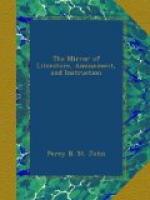163. A State Quarry. De Loutherbourg.
165—167. Portraits of Worlidge and Mortimer. Painted by themselves.
172. Villa of Maecenas. One of Wilson’s most celebrated compositions, of classic fame.
181. Master’s Out, “The Disappointed Dinner Party.” R.W. Buss. A scene of cockney mortification humorously treated.—An unlucky Londoner and his tawdrily-dressed wife, appeared to have toiled up the hill, with their family of four children, to a friend’s cottage, the door of which is opened by an old housekeeper, with “Master’s out,” while the host himself is peeping over the parlour window-blind at the disappointment of his would-be visitors. The annoyance of the husband at the inhospitable answer, and the fatigue of his fine wife, are cleverly managed; while the mischievous pranks of the urchin family among the borders of the flower-garden remind us of the pleasant “Inconveniences of a Convenient Distance.” The colouring is most objectionable; though the flowers and fine clothes are very abundant.
194. Falls of Niagara. Wilson. A sublime picture of this terrific wonder of the world.
196. Erzelin Bracciaferro musing over Meduna, slain by him for disloyalty during his absence in the Holy Land. Fuseli. A composition of touching melancholy, such as none but a master-mind could approach.
199. The late R.W. Elliston, Esq. One of Harlow’s best portraits: the likeness is admirable, and the tone well accords with Elliston’s unguent, supple expression.
204. Portrait of Dr. Wardrope. Raeburn. This is one of the artist’s finest productions: it is clever, manly, and vigorous—painting to the life, without the flattering unction of varnished canvass. The fine, broad, bold features of the sitter were excellently adapted to the artist’s peculiar powers.
205. Portrait of Thomson, the Poet. Hogarth. The well-known picture. How fond poets of the last century were of their dishabille in portraits: they had their day as well as nightcaps.
217. Johnny Gilpin. Stothard. This lively composition is well known, as it deserves to be; but it may not so well be remembered that the popularity of John Gilpin was founded by a clever lecturer, who recited the “tale in verse” as part of his entertainment. (See page 367.) What would an audience of the present day say to such puerility; though it would be certainly more rational than people listening to a French play, or an Italian or German opera, not a line of which they understand.
229. Portrait of R.B. Sheridan. The well-known picture, by Reynolds, whence is engraved the Frontispiece to Moore’s Life of the Statesman and Dramatist. Here is the “man himsel,” in the formal cut blue dress-coat and white waistcoat of the last century. The face may be accounted handsome: the cheeks are full, and, with the nose, are rubicund—Bacchi




